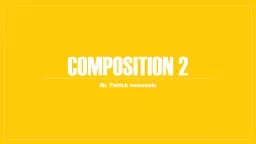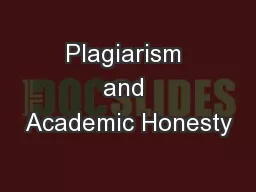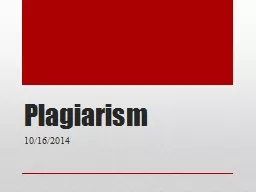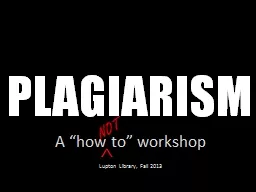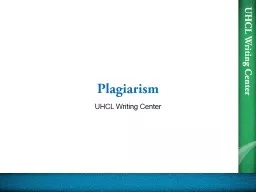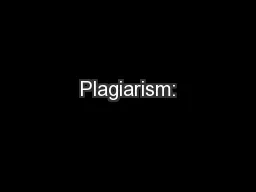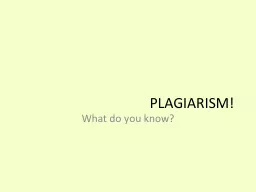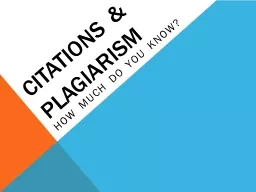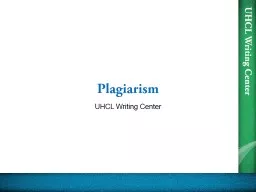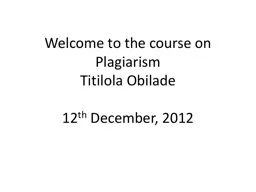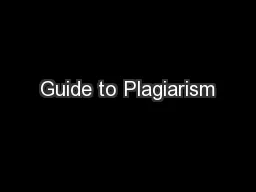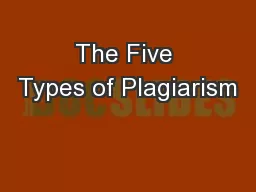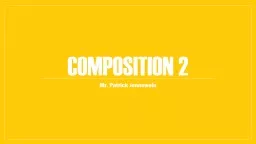PPT-Plagiarism 101: Comp 2 Mrs. Hackworth
Author : pamella-moone | Published Date : 2018-09-20
Plagiarism T he process of taking someone elses work or ideas and passing them off as ones own There are ten different types of plagiarism You do not need to
Presentation Embed Code
Download Presentation
Download Presentation The PPT/PDF document "Plagiarism 101: Comp 2 Mrs. Hackworth" is the property of its rightful owner. Permission is granted to download and print the materials on this website for personal, non-commercial use only, and to display it on your personal computer provided you do not modify the materials and that you retain all copyright notices contained in the materials. By downloading content from our website, you accept the terms of this agreement.
Plagiarism 101: Comp 2 Mrs. Hackworth: Transcript
Plagiarism T he process of taking someone elses work or ideas and passing them off as ones own There are ten different types of plagiarism You do not need to know these wordforword but try to understand the ideas . In academic writing you need. to show that you have researched your subject. to acknowledge the sources you have used to avoid the charge of plagiarism. to ensure that it is your own work written in your own words avoiding collusion. From Strake Jesuit College Preparatory . Community Life . 2015-2016. Academic Honesty. Honor and character can be defined as, “what one does when no one else is watching.” . A person’s honor is bound up with his or her integrity. . 10/16/2014. Inappropriate Paraphrasing. Original source (text. ). “From time to time this submerged or latent theater in Hamlet becomes almost overt. It is close to the surface in Hamlet’s pretense of madness, the “antic disposition” he puts on to protect himself and prevent his antagonists from plucking out the heart of his mystery. It is even closer to the surface when Hamlet enters his mother’s room and holds up, side by side, the pictures of the two kings, Old Hamlet and Claudius, and proceeds to describe for her the true nature of the choice she has made, presenting truth by means of a show. Similarly, when he leaps into the open grave at Ophelia’s funeral, ranting in high heroic terms, he is acting out for Laertes, and perhaps for himself as well, the folly of excessive, melodramatic expressions of grief.”. A “how to” workshop. Lupton Library, Fall 2013. NOT. ^. Stealing?. WHAT IS PLAGIARISM?. Plagiarism is the act of presenting another person’s words, work, or ideas as if they are your own.. It’s fraud. Not theft.. UHCL Writing Center. What is plagiarism?. From Latin root of “kidnap,” . plagiarist . meaning “literary thief,” . plagiarism. meaning “the act of stealing literature”. In short, not giving proper credit for using someone’s writing or words.. Clarifying . OSU's Approach. Stefanie Buck, Instructional Design and Ecampus Librarian, OSU Libraries. Lynn Greenough, Instructional Technology Specialist, TAC. Raphelle Rhoads,. College Student Services . What do you know?. Has this student plagiarized? . One could argue that the city of Las Vegas, Nevada, is a metaphor of our national character and aspiration, with its symbol of a thirty-foot-high cardboard picture of a slot machine and a chorus girl.. How much do you know?. Lauren Arrowsmith. Visiting Business Librarian. Olin Library, Rollins College. larrowsmith@rollins.edu. Question 1:. You . do research and take notes in your own words. Later, when typing your paper, you do not give credit to the author because you are not using the author’s exact words. You are plagiarizing your research. . Dr Cordelia Beattie. School Academic Misconduct Officer. . Plagiarism:. . . Plagiarism:. . Hard to Spell, Easy to Do. . Plagiarism:. . Hard to Spell, Easy to Do. Plagiarism is a . SERIOUS ACADEMIC. UHCL Writing Center. What is plagiarism?. From Latin root of “kidnap,” . plagiarist . meaning “literary thief,” . plagiarism. meaning “the act of stealing literature”. In short, not giving proper credit for using someone’s writing or words.. Titilola. . Obilade. 12. th. December, 2012. Outline. Shared Objective. Reflections. Definition of Plagiarism. Four Authentic Examples of Plagiarism. Live Audio Chat. Assessment. The outline is an advance organizer informing students of what to expect in the lesson on plagiarism.. Overview. What is plagiarism?. Quiz. Types of plagiarism.. Consequences of plagiarism.. How to avoid plagiarism.. Questions. ?. Defining Plagiarism. Basic Definition. “. Merriman-Webster. ”. (2012), defines plagiarism as . How to Understand and Avoid Academic Dishonesty. Adapted . by Professor Foss from Theresa . Waliezer’s. in-class presentation. Presenting another’s original thoughts or ideas as your own. Using another’s exact words without . Plagiarism: . . T. he process of . taking someone else's work or ideas and passing them off as one's own.. There are ten different types of plagiarism:. You do not need to know these word-for-word, but try to understand the ideas. .
Download Document
Here is the link to download the presentation.
"Plagiarism 101: Comp 2 Mrs. Hackworth"The content belongs to its owner. You may download and print it for personal use, without modification, and keep all copyright notices. By downloading, you agree to these terms.
Related Documents

